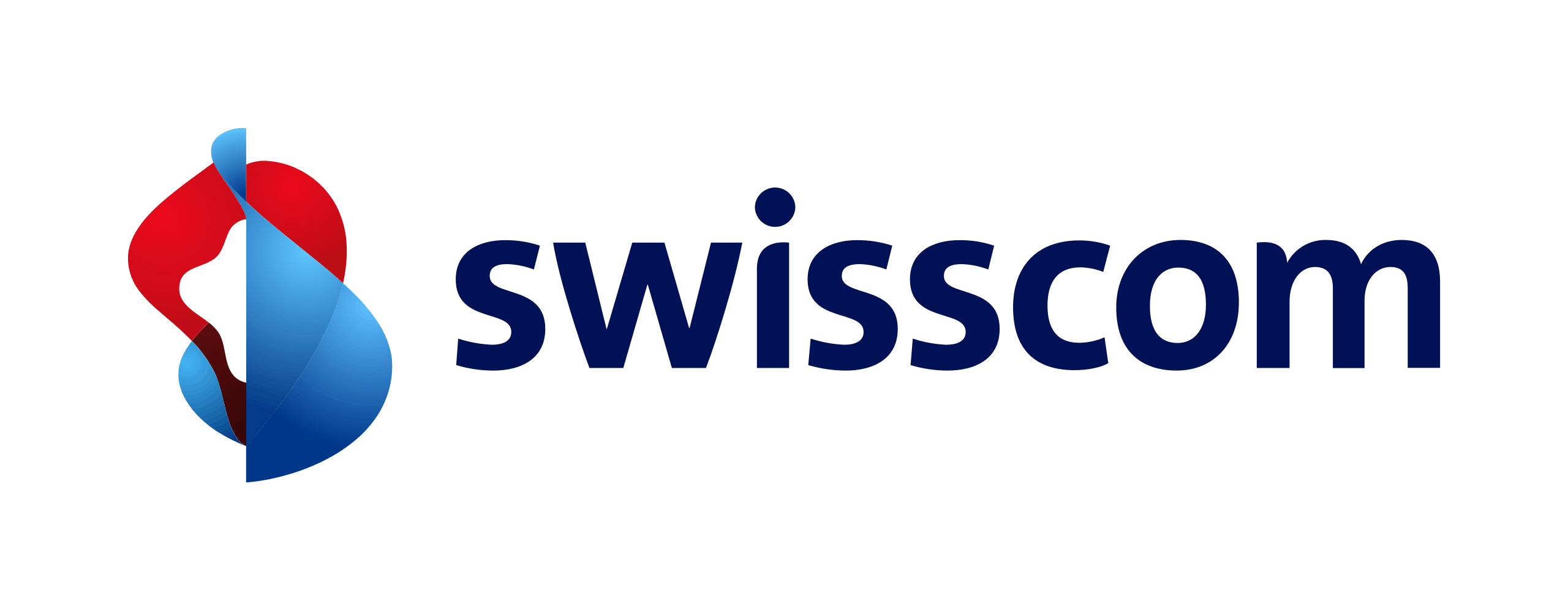Learn the basics of Software Asset Management – Become a SAM expert in your company.
In 7 practical modules, you will learn the essential basics of Software Asset Management to precisely control license costs, effectively minimize compliance risks, and confidently pass audits.
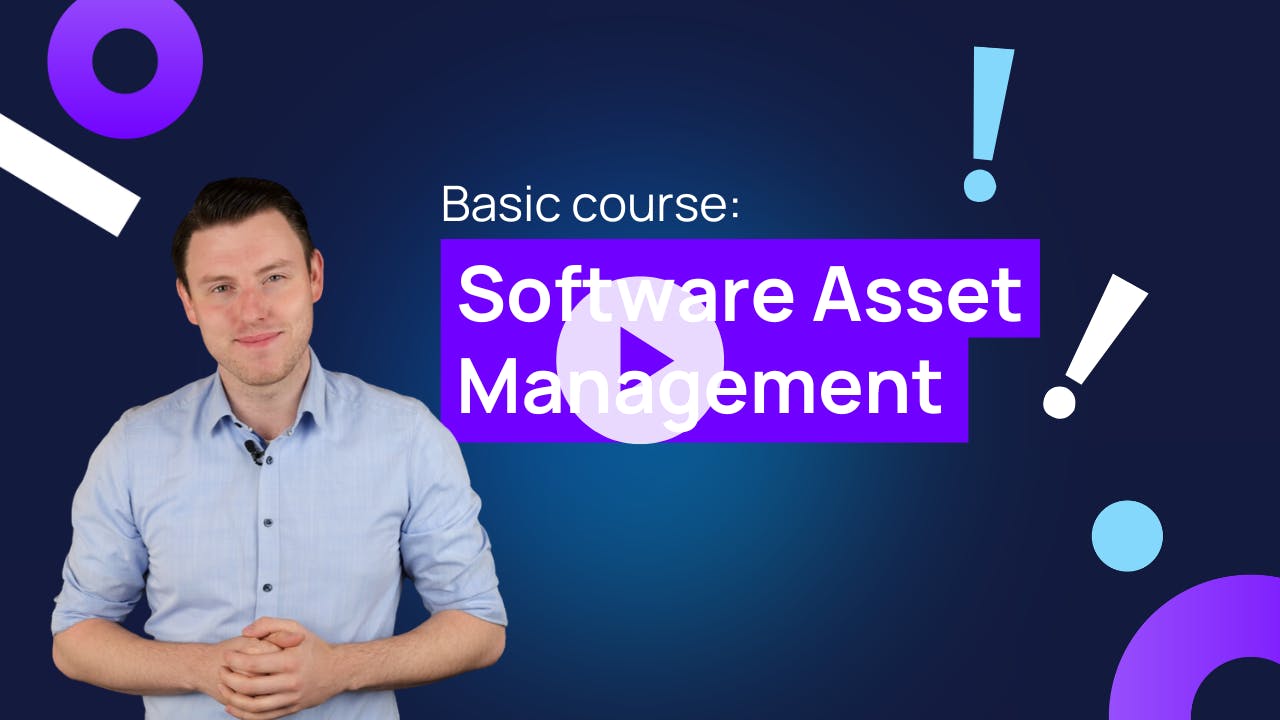
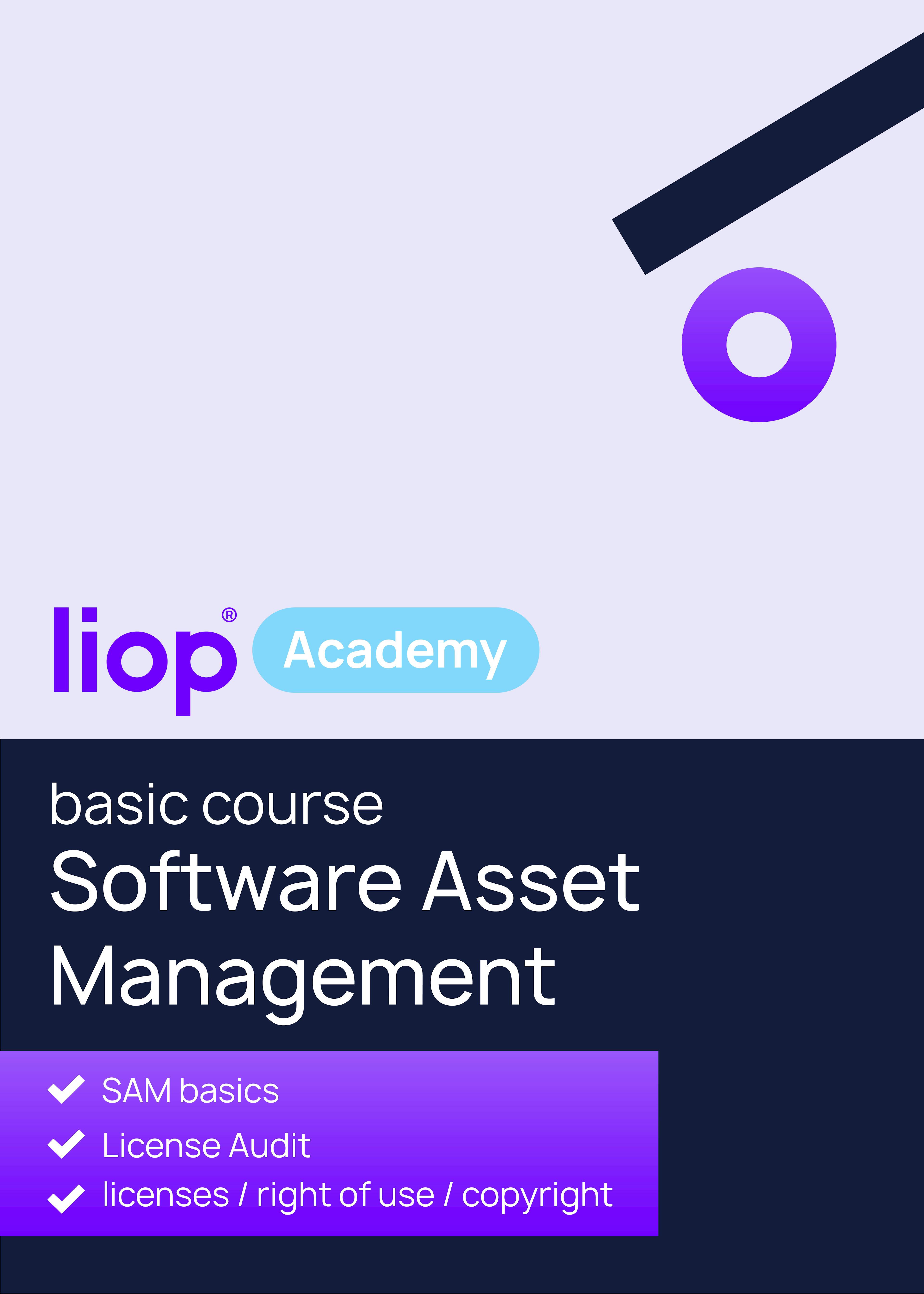
About the Course
As a career changer or beginner in the field of Software Asset Management (SAM) according to ISO 19770, you will receive the necessary knowledge in this course to manage securely and correctly.
- Avoid expensive compliance issues: Learn how to correctly manage software assets and confidently face audits. Our course teaches you exactly what matters in software licensing and management.
- Lasting expert knowledge in a short time: With little time investment, you will get a solid introduction to the key concepts of SAM. The course offers you compact knowledge on SAM policies, licensing, and legal aspects. Practical applications help you quickly get to implementation and directly apply the necessary knowledge.
- Building internal expertise: Effectively establish SAM processes in your company without consultants. With tailored knowledge and practical approaches, you will become the central contact person for all questions related to Software Asset Management and rise to become the key person for efficient software management.
3 Reasons for the Course
Software Asset Management Basics according to ISO 19770
Benefits

Time Savings through Structured Management
The course offers you a clear and structured introduction to SAM processes, helping you save time in managing software resources while ensuring efficient and organized management.

Confidence and Security
Through the course, you will acquire the necessary knowledge to comply safely with licensing requirements and prepare specifically for audits. This gives you the confidence to navigate audit situations smoothly and minimize potential risks effectively.

Economic benefits and achieving KPIs
By optimizing software usage and costs, you are significantly contributing to reducing overall software license expenses in the company. This positions you as an employee who thinks economically and actively contributes to the achievement of important company KPIs.
Who is this course suitable for?
Beginners in Software Asset Management
You will receive a solid introduction to the basics of SAM to efficiently master software management and licensing
IT and procurement staff
Learn how to develop SAM policies and manage software licenses correctly to ensure compliance and optimize costs.
Project managers and IT leaders
This course gives you the knowledge to effectively implement SAM processes and make strategic decisions.
Career changers to IT management
If you are coming from another field, build a solid foundation in SAM with this course to quickly and effectively work in your new area.
Company leaders and decision-makers
Learn how to make better decisions about IT budgets and investments through profound SAM knowledge and achieve long-term efficiency gains.
Problems & Negative Consequences
without in-depth knowledge of SAM
With this course, you solve the following challenges:
Increase your influence and make a difference
Your in-depth knowledge and clearly structured processes enable you to strategically influence all stakeholders. You actively contribute to improving corporate strategies and are perceived as a valuable employee with an economic perspective.
Reduce stress and enjoy more security
Thanks to the clear structure and documentation of your SAM processes, stress becomes a thing of the past. You can sleep soundly because you can rely on a solid foundation.
Better prepare for procurement strategies
With a systematic approach, you can strategically plan purchasing strategies for the long term. You make informed decisions and stay in control.
Become more than just an administrative employee
Through effective management of your software assets, you will be recognized as a key person in the company. Your contribution will be seen as valuable and strategic, and you will demonstrate initiative and leadership.
Gain in-depth knowledge of SAM concepts and best practices
With the course, you get a strong basis for discussions. Your knowledge enables you to make informed decisions and communicate your strategy clearly.
Develop clear SAM policies and processes
You create structured SAM policies that provide clarity and transparency in software management. This simplifies your daily tasks and enables process optimization.
Prepare effectively for audits and understand legal aspects
You minimize compliance risks and effectively prepare for audits. This helps you avoid high costs and legal issues.
Build and maintain a software catalog for cost control
You learn how to build and maintain an effective software catalog, which helps you better control costs and utilize resources efficiently.
Optimize management and create space for new projects
By efficiently automating and structuring management, you create space for strategic projects. This promotes economic efficiency and increases your enjoyment at work.
All course contents
at a glance
Contents
Clarification of Terms in Software Asset Management
After Module 1, you will understand the central terms of Software Asset Management, recognize the differences between ITAM, SAM, and LIMA, and be able to create a comprehensive SAM policy.
You will secure:
- Understanding of basic terms: Learn about the central terms of Software Asset Management (SAM) such as “license”, “copyright”, “usage rights”, and “license audit”. These terms are essential for understanding and correctly applying SAM practices.
- Explain the goals of ITAM/SAM/LIMA: Understand the differences and aims of the various asset management methods like IT Asset Management (ITAM), Software Asset Management (SAM), and License Management (LIMA). Recognize how these concepts interact to ensure efficient management of software assets.
- Understand from the ground up how to create a comprehensive SAM policy that defines guidelines and processes for managing and using software. This is crucial for proper and legally compliant software management.
- Utilize practical resources: The course includes a glossary of key terms that serves as a useful reference tool. This way, you can always refer to clear definitions and explanations.

Licenses, Usage Rights, and Copyright
After Module 2, you will understand the different types of software licenses and usage rights, recognize their impact on software management, and correctly classify copyright.
You will learn about:
- Understanding licenses: Learn the basics and types of software licenses and their significance for software usage and management.
- Clarifying usage rights: Learn how usage rights are defined and distinguished from licenses.
- Classifying copyright: Understand the impact of copyright on software licenses and their application.
- License metrics and forms: Get an overview of various license metrics and forms relevant to software licensing.

Open Source Software
After Module 3, you will know the differences between open-source and proprietary software, understand the principles of copyleft, and be able to grasp various types and licenses of open-source software.
You will learn:
- Clarifying the term Open Source: Gain a clear definition and understanding of Open Source Software (OSS) and its differences from proprietary software.
- Open Source and Copyleft: Learn the principles of Copyleft and how they affect the use and distribution of Open Source Software.
- Types of Open Source Software: Get an overview of various types and licenses of Open Source Software and their specific requirements.
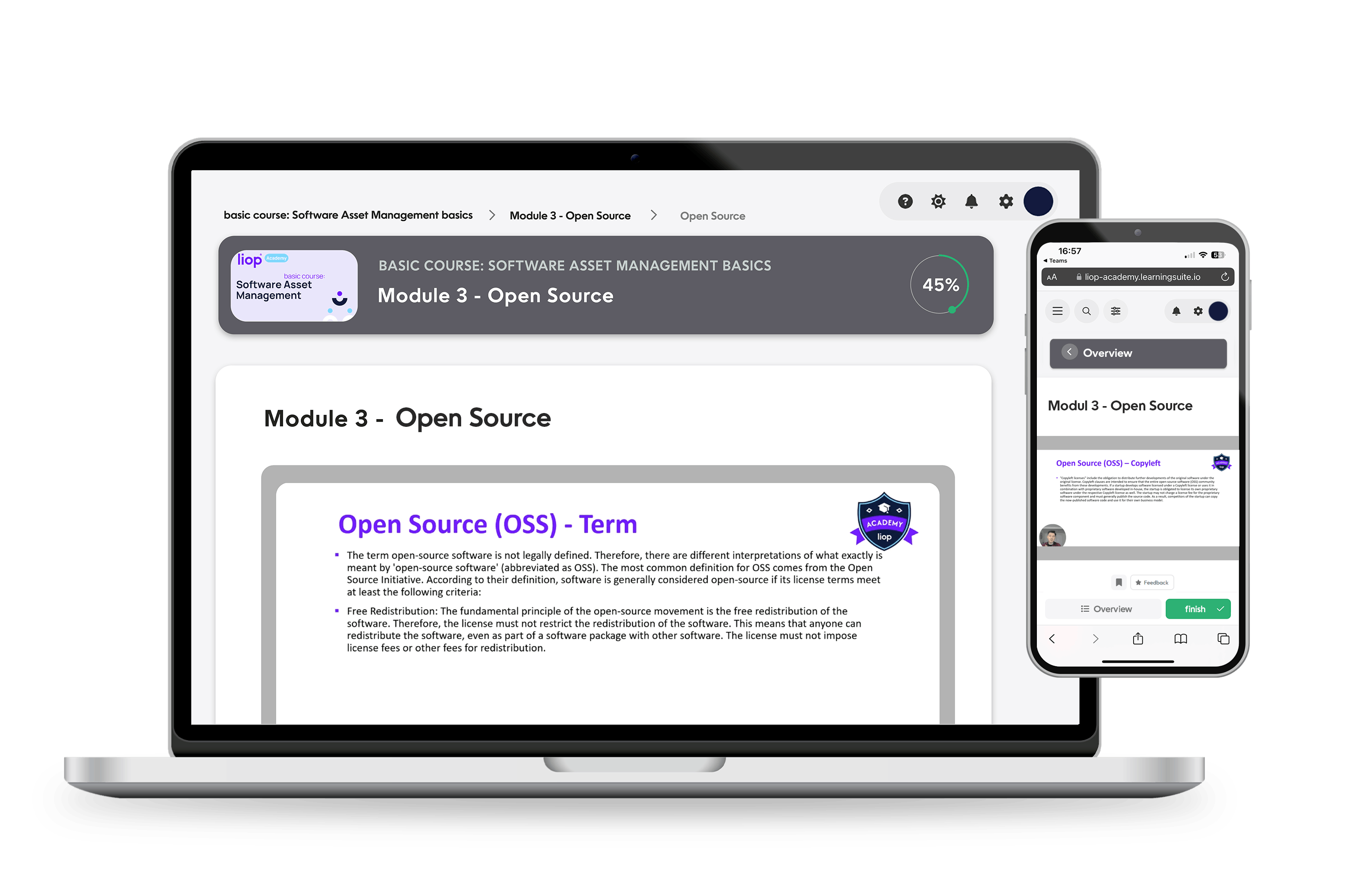
Copyright
After Module 4, you will understand the copyright protection mechanisms for software, analyze practical examples, and be able to classify the corporate aspects of copyright.
You will learn:
- Understanding copyright: Learn what copyright is and what protection mechanisms it offers for software.
- Analyzing practical examples: Using concrete examples, you will see how copyright is applied in practice.
- Considering corporate aspects: Learn how copyright is embedded in the legal framework of companies and its impact on dealing with software licenses.
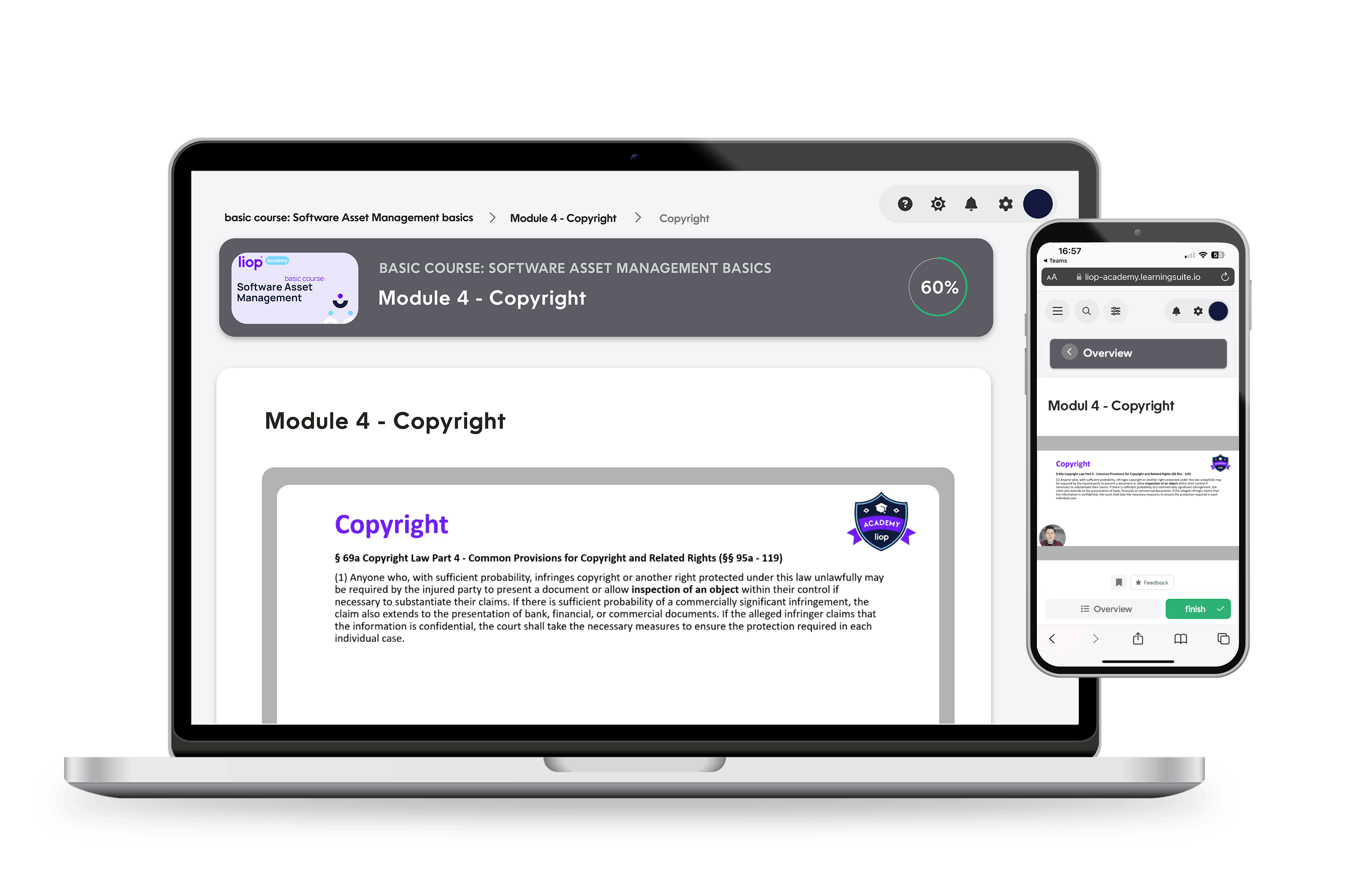
License Audit
After Module 5, you will understand the motivation of manufacturers for audits, be able to manage the lifecycle of an audit, and prepare yourself specifically for audits, including cloud audits.
You will learn:
- The motivation of manufacturers for audits: Understand why software manufacturers conduct audits and what goals they pursue.
- What exactly is an audit: Learn the definition of a license audit and the legal foundations that exist for it.
- The consequences an audit can have for your company: Discover the potential consequences and how you can prepare for them.
- The causes that lead to audits: Examine the factors that frequently trigger audits and how to minimize these risks.
- The lifecycle of an audit: Follow the phases of an audit from the announcement to the conclusion and understand how to manage the process effectively.
- How to efficiently organize an audit: Learn the key roles and responsibilities in conducting an audit.
- What to consider in cloud audits: Learn how audits differ when using cloud services and the specific requirements that exist.
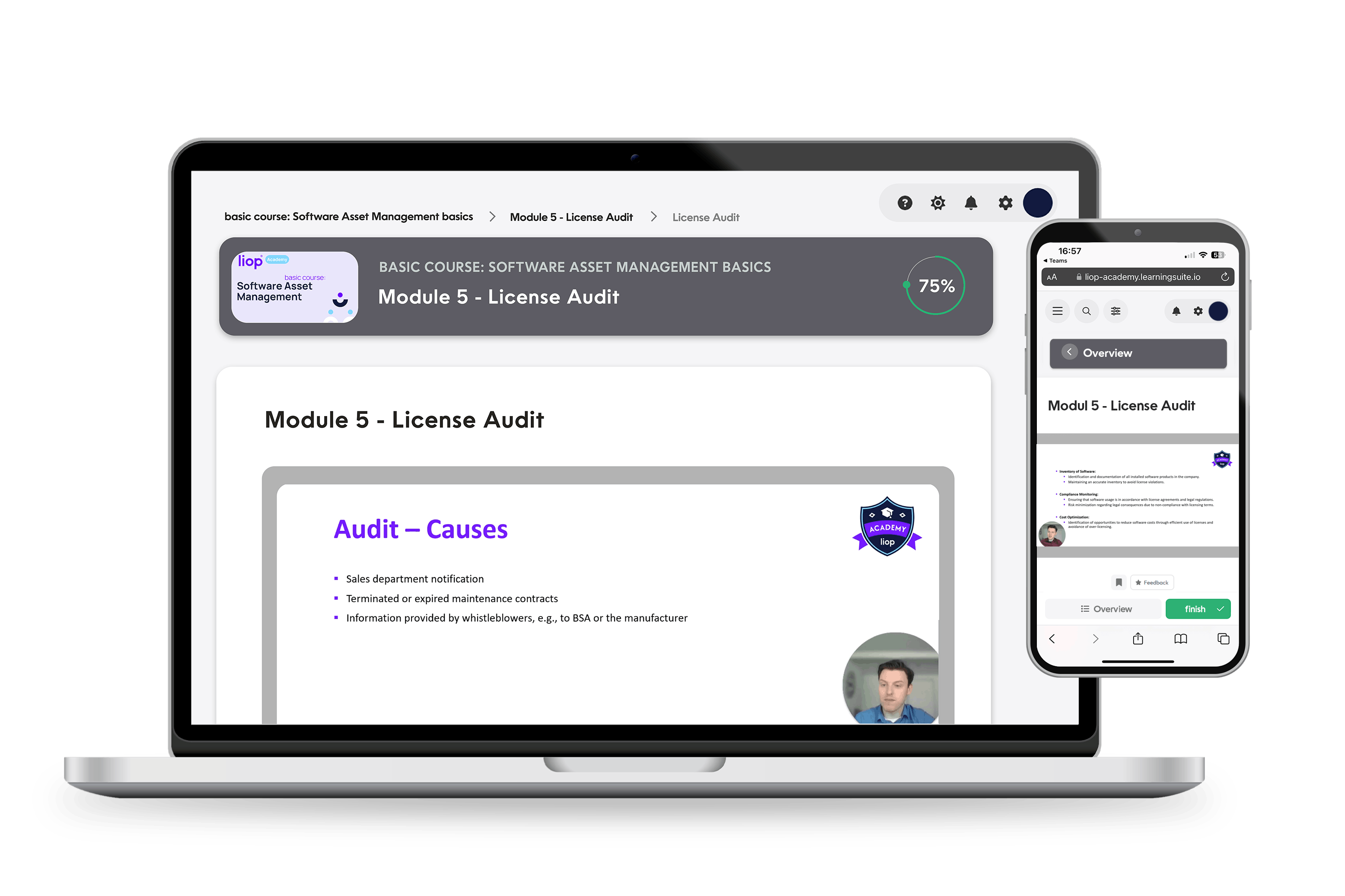
Used Software
After module 6, you will know the legal fundamentals of used software, understand the conditions for its usage, and be able to identify the differences between new and used software licenses.
You will learn:
- Which legal fundamentals apply to used software: You will understand which legal provisions govern the trade and usage of used software.
- Who can use used software: Learn the conditions that must be met to legally use used software.
- What a used software license is: Understand the differences between new and used software licenses and the special aspects to be aware of.
- How the usage rights and license agreements are structured: You will examine which regulations in the usage rights and license agreements for used software are important.
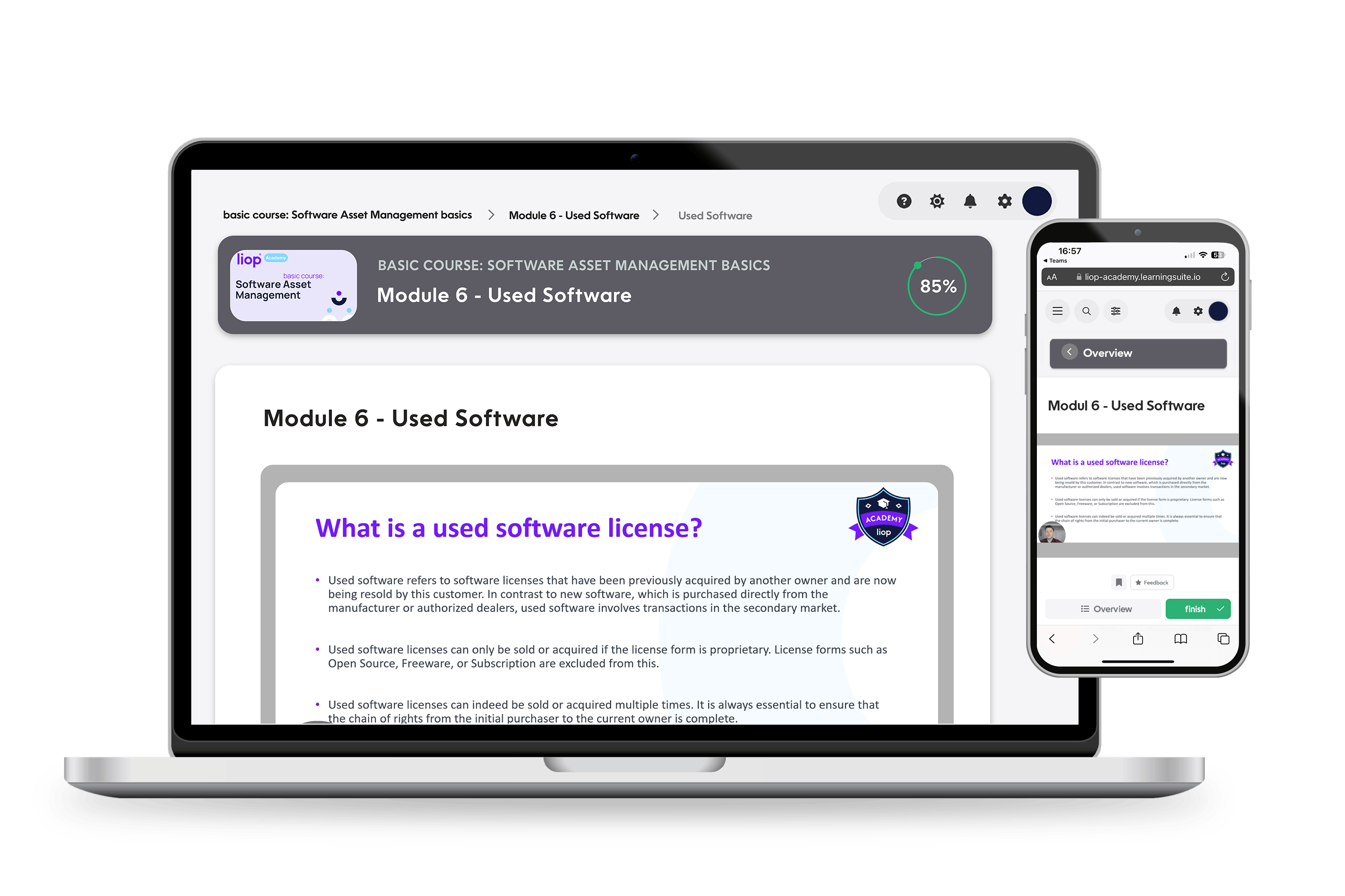
Creating a Software Catalog
After this Practical Module 1, you will be able to create an effective software catalog that optimizes the procurement process, facilitates budget planning, and enables controlled
In this practical module, you will:
- Understand the benefits of a software catalog: You will learn how a well-structured software catalog can help your company improve the management and control of software licenses.
- Optimize the software procurement process: You will learn how a software catalog makes the procurement process more efficient and helps avoid discrepancies.
- Reduce the SKU list for budget planning: Understand how maintaining a software catalog can minimize the number of Stock Keeping Units (SKUs) to facilitate budget planning.
- Support license management: You will see how the software catalog simplifies the approval process for the introduction of new software applications and ensures that all software purchases comply with internal policies.
- Ensure protection from an uncontrolled software environment: Learn how a software catalog helps maintain a controlled and secure software environment in your company.
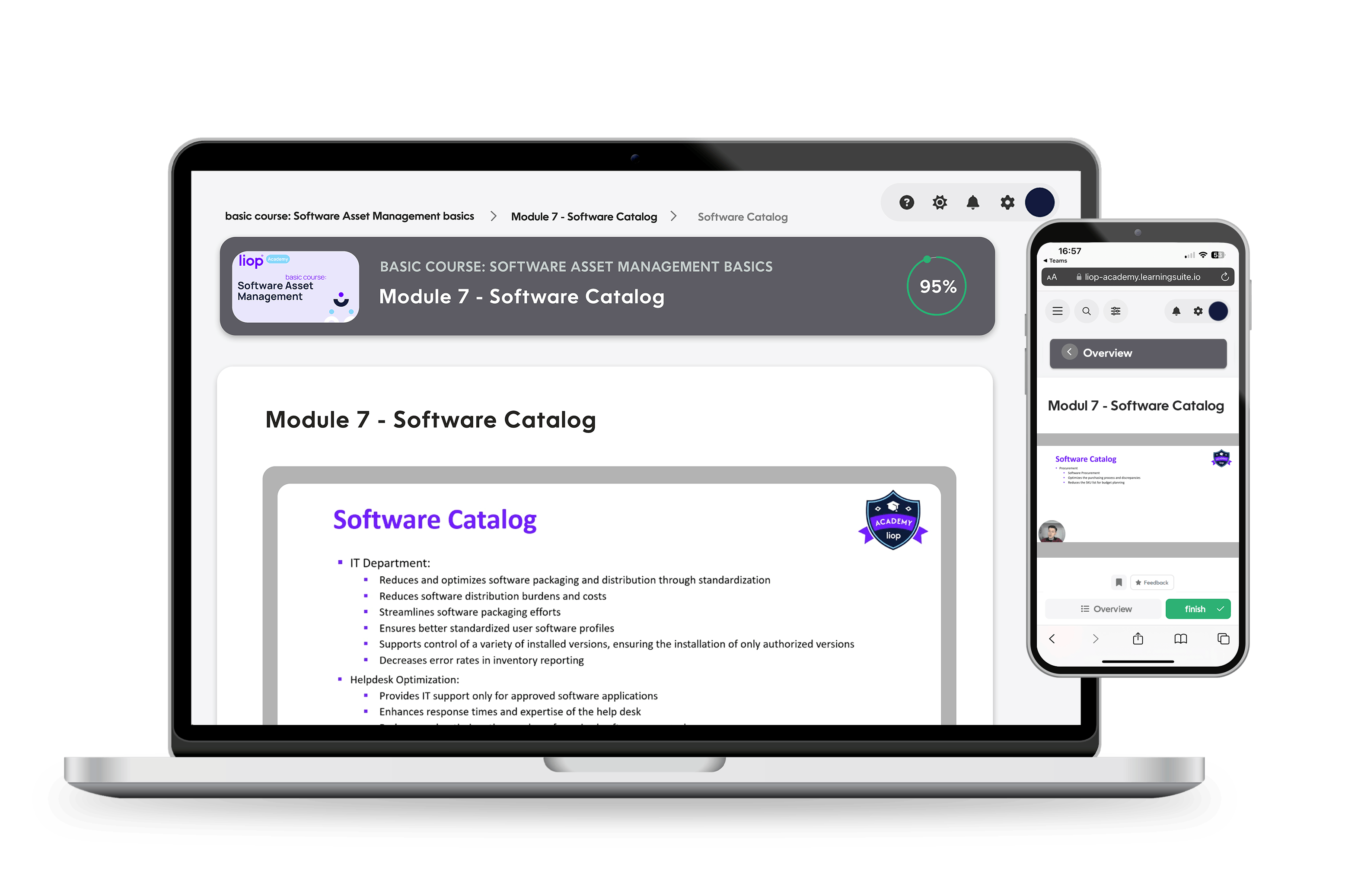
SAM Tools
After module Practical Module 2, you will be able to use SAM tools efficiently, maintain an accurate license balance, and utilize license pooling to optimize your software management.
In this practical module, you will:
- Conduct practical exercises: Learn through practical applications how to effectively use SAM tools to manage and optimize software assets.
- Create a license balance: Learn how to keep an accurate license balance to keep track of your software licenses and their usage.
- Use license pooling: Understand how license pooling works and how you can optimize costs and improve license usage by bundling licenses.
- Implement the tasks of a Software Asset Manager: Gain insights into the daily tasks and responsibilities of a Software Asset Manager to efficiently fulfill your role and improve software management.
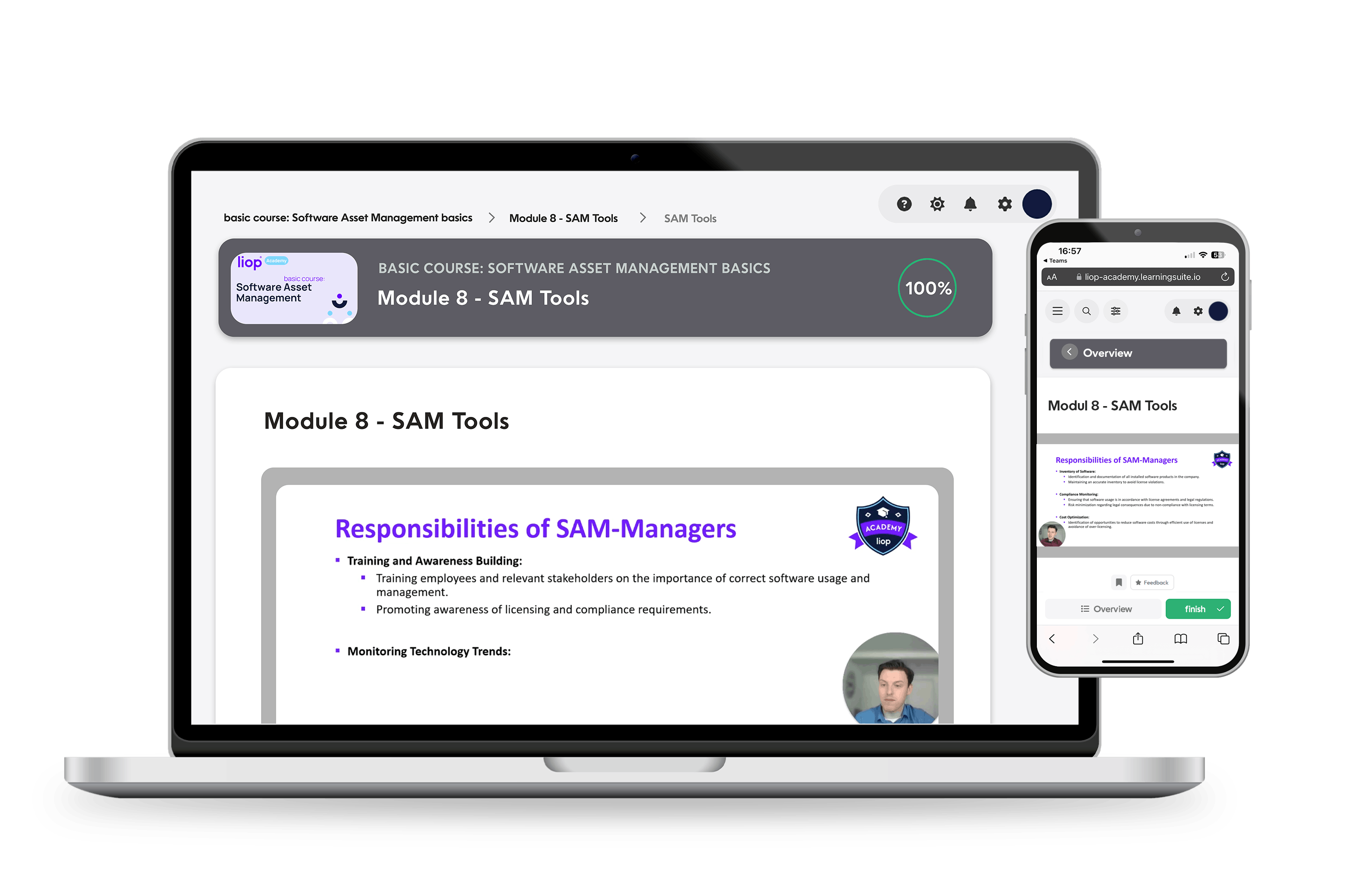
Your Trainer
About us
These companies trust the courses of the liop® Academy
References
Qualifications of the liop® Academy

Experienced Trainers
Our trainers have many years of experience in IT and license management - both in theory and in practice.

Vendor Independent
We combine many years of experience with practical and knowledge-oriented teaching, without vendor affiliation.

Reduced Complexity
We have reduced our courses to essential expertise to offer time-saving compact courses.

Multilingual Courses
Our courses are available in both German and English.
Frequently Asked Questions

